Posts Tagged ‘rosemary’
Thursday, October 24, 2013

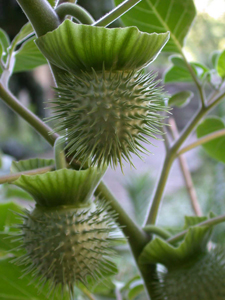
While rosemary was a familiar herb of the Mediterranean littoral in antiquity, the date of its introduction into Northern Europe is uncertain, and it was not grown in England until the fourteenth century. The thorn apple, Datura metel, did not reach Europe from India until the fifteenth century, although it is mentioned in Islamic sources at an earlier date.
Much as architectural elements from different periods and locales in medieval Europe were transported to New York and integrated into a single modern building, the herbs, fruits, and flowers growing in the gardens were transplanted, traveling across time and space to their home at The Cloisters.
Read more »
Tags: Datura, Datura metel, rosemary, thorn apple
Posted in Gardening at The Cloisters, The Medieval Garden | Comments (3)
Friday, May 25, 2012
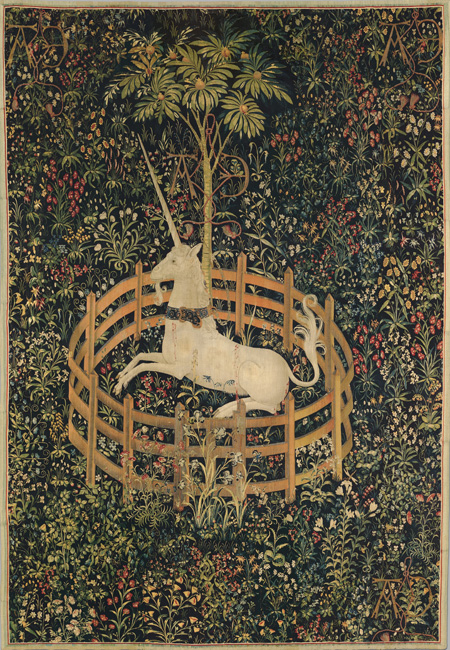
The Unicorn in Captivity, 1495???1505. The Metropolitan Museum of Art, New York, Gift of John D. Rockefeller Jr., 1937 (37.80.6). The profusion of flowering plants that springs from the millefleurs meadow on which the unicorn rests includes both garden plants and wildflowers. An iris and a clove pink are prominently placed outside the unicorn’s enclosure; both were intensively cultivated in the Middle Ages, but the purple orchis silhouetted against the unicorn’s body depends on a special relationship with microorganisms in its native soil and would not have grown in gardens.
Roses, lilies, iris, violet, fennel, sage, rosemary, and many other aromatic herbs and flowers were prized for their beauty and fragrance, as well as their culinary and medicinal value, and were as much at home in the medieval pleasure garden as in the kitchen or physic garden. These plants were carefully cultivated, but many useful plants of the Middle Ages were found outside the garden walls, or admitted on sufferance.
Read more »
Tags: colewort, Fennel, gourd, herb, Hortulus, iris, kale, lamb's quarters, lettuce, lily, melon, nettle, poppy, pulse, purslane, rose, rosemary, sage, violet, Walahfrid Strabo
Posted in Food and Beverage Plants, Fragrant Plants, Medicinal Plants, Plants in Medieval Art, Useful Plants | Comments (1)
Friday, February 10, 2012
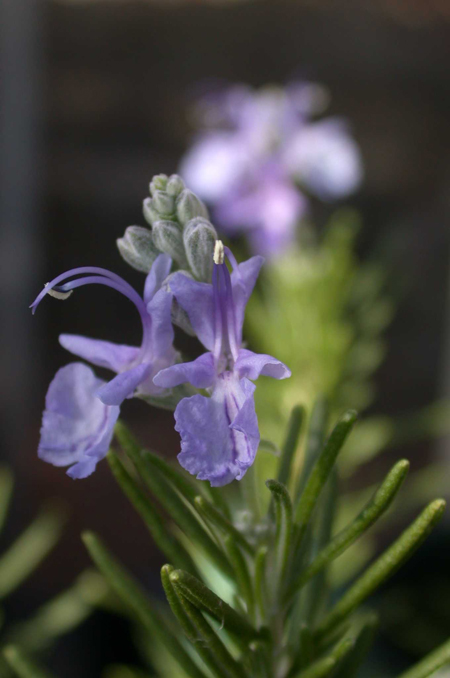
In the later Middle Ages, the leaves, stems, and flowers of this aromatic??member of the mint family??were used to effect cures for many ills, and provide protection from both spiritual and bodily harm. Photograph by Nathan Heavers
Libanotis which the Romans call Rosmarinus & they which plait crowns use it: the shoots are slender, about which are leaves, small, thick, and somewhat long, thin, on the inside white, but on the outside green, of a strong scent. It hath a warming facultie . . .
???Dioscorides, De Materia Medica, Book III: 89
It is an holy tree and with folk that hath been rightful and just gladly it groweth and thriveth. In growing it passeth not commonly in height the height of our Lord Jesu Christ while he walked as a man on earth, that is man’s height and half, as man is now; nor, after it is 33 years old, it growth not in height but waxeth in breadth and that but little. It never seareth all but if some of the aforesaid four weathers make it.
???Friar Henry Daniel, “little book of the virtues of rosemary,” ca. 1440
Read more »
Tags: Dioscorides, Hortulus, rosemary, Rosmarinus officinalis, Salerno, St. Gall, Walahfrid Strabo, Westminster, Wilton Diptych
Posted in Medicinal Plants, Plants in Medieval Art, The Medieval Garden | Comments (1)
Friday, October 28, 2011
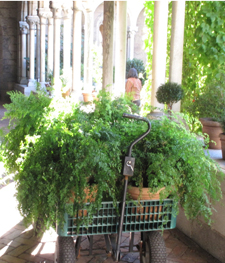
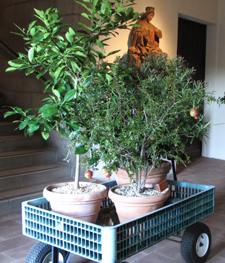
Potted plants too tender to spend the winter in Bonnefont garden are trucked inside and brought up to Cuxa cloister, which is??glazed in mid-October. Mediterranean plants such as bitter orange, myrtle, and bay laurel spend the cold season in the sunny arcades and??are brought back out to the herb garden when the glass comes down in mid-April. Left:??A wagonload of maidenhair fern in the arcade of Bonnefont garden. Right:??oranges and pomegranates en route to Cuxa cloister.?? Photographs by Carly Still
While the medieval plant collection at The Cloisters includes a good number of northern European species, a great many of the plants grown in the Bonnefont Cloister herb garden are Mediterranean in origin. Not all of these southern European plants are hardy for us here in New York City. The garden is a sheltered U.S.D.A. Hardiness Zone 7, and the fig tree (Ficus carica), poet’s jasmine (Jasminum officinale), and lavender (Lavandula angustifolia) do just fine outdoors, but more tender species like bitter orange (Citrus aurantium), rosemary (Rosmarinus officinalis), bay laurel (Laurus nobilis), and dittany of Crete (Origanum dictamnus) must be brought inside and protected from the cold. Read more »
Tags: Albertus Magnus, bay, Citrus aurantium, cucumber, cucurbit, dittany, fern, ficus carica, fig, jasmine, Jasminum officinale, laurel, Laurus nobilis, Lavandula angustifolia, Lavender, maidenhair, myrtle, orange, Origanum dictamnus, rosemary, Rosmarinus officinalis, santolina, winter
Posted in Food and Beverage Plants, Fragrant Plants, Gardening at The Cloisters, Introduction, Magical Plants, Medicinal Plants, Medieval Agriculture, Plants in Medieval Art | Comments (2)
Wednesday, February 11, 2009
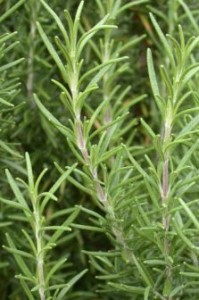
Above: A closer look at rosemary (Rosmarinus officinalis).
Most people who try to overwinter rosemary (Rosmarinus officinalis) inside are familiar with powdery mildew, Erysiphe sp. Similar to the whitefly I discussed in the earlier post, this fungus is favored by the indoor conditions that are typically provided in attempt to overwinter rosemary. Read more »
Tags: herb, Neem oil, organic, pest, powdery mildew, rosemary, Rosmarinus officinalis
Posted in Food and Beverage Plants, Gardening at The Cloisters | Comments (4)
Friday, January 30, 2009
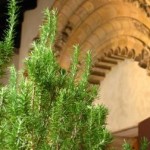
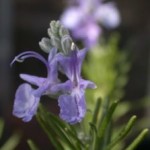
Left: Rosemary (Rosmarinus officinalis) in the arcade of Cuxa Cloister; right: a rosemary plant in flower.
Although rosemary (Rosmarinus officinalis) is one of the most popular plants at The Cloisters for its great ornamental value and colorful history, this plant does have its problems, which become especially evident when we bring it indoors during the winter months. Read more »
Tags: herb, Neem oil, powdery mildew, rosemary, Rosmarinus officinalis, whitefly
Posted in Food and Beverage Plants, Gardening at The Cloisters | Comments (10)
Friday, January 23, 2009
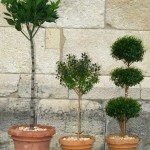
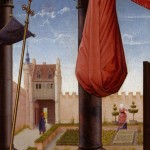
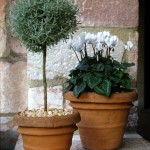
Above, from left to right: Topiaries in the plant collection at The Cloisters; detail from The Annunciation, 1465???75, Workshop of Rogier van der Weyden (possibly Hans Memling, active by 1465, died 1494) (Netherlandish, 1399/1400???1464), The Metropolitan Museum of Art, New York, Gift of J. Pierpont Morgan, 1917 (17.190.7); cotton lavender topiary in Cuxa Cloister.
Medieval topiary was relatively simple and non-representational. Woody plants were trained to standards topped by balls, or to a characteristically medieval form known as an estrade, in which the plant was grown in tiers. Although these are rarely represented before 1400, many fifteenth-century artworks show estrades and other simple, geometric forms growing both in pots and in garden beds. The more ornate representational topiary known to the Romans was revived in Renaissance Italy; the Rucellai garden in Florence, created in the second half of the fifteenth century, included animals and human figures, as well as topiary temples and urns.
The practice of artfully clipping and training woody plants into formal or fanciful shapes can be traced back to imperial Rome and the Natural History of Pliny the Elder, who attributes the relatively recent invention of nemora tonsilia or “barbered groves” to one Gaius Matius, a Roman knight and a friend of the Emperor Augustus (John Boardman, The Oxford History of the Roman World, 2001). Read more »
Tags: bay, cotton lavender, estrade, herb, Laurus nobilis, Myrtis communis, myrtle, rosemary, Rosmarinus officinalis, Santolina chamaecyparissus, topiary
Posted in Fragrant Plants, Gardening at The Cloisters | Comments (6)












